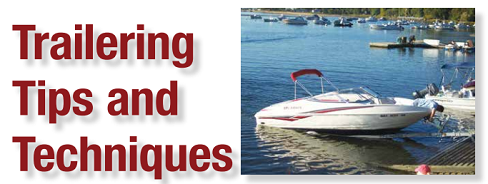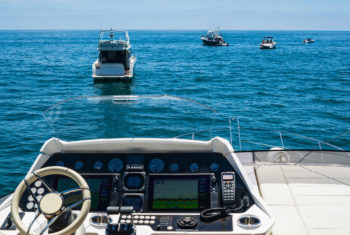Proper boat trailering is a bit harder than it looks, but with practice, a thorough checking of equipment, and always following the same step-by-step procedures, you’ll prevent mishaps and preserve both your dignity and vessel.
Your first step is making sure you have the proper tow package or correct hitch to go with a towing-capable vehicle. Check with the dealership and the trailer manufacturer to make sure vehicle, trailer, and vessel are compatible.
Practice is vital — driving with a boat or jet ski attached to a trailer is a skill that comes with time. Head to an empty parking lot and drive slowly, as you note how much more time it takes you to perform routine maneuvers such as accelerating, turning, and braking. Observe how much wider turns are, including the point you’ll need to start turning to avoid jumping a curb or median. Practice backing up to see what direction the trailer turns as the vehicle goes left and then right (backing up requires turning the steering wheel in the opposite direction that you want the trailer to turn). Get a feel for accelerating onto a high-traffic road and coming to a complete stop.
After you’ve got a handle on maneuvering on the road, you’ll need to practice at the water. Do so at an off-time at a deserted ramp (or practice doing as much as possible away from the action) — you need to develop an aptitude for smoothly and efficiently launching and retrieving your vessel without other skippers yelling that you’re holding them up.
Steps at a ramp:
- Check the vessel thoroughly to make sure no damage occurred on the trip.
- Remove supports, raise the lower unit, remove tie-downs, and ensure the winch is properly attached and locked into position.
- Check that the drain plug is in and secure.
- Disconnect the trailer lights.
- Attach a line to both stern and bow to grab while launching.
- Check the launch area for hazards including broken concrete, slippery oil or soap suds, spilled gas, and a steep drop-off.
- Start backing up, but stop before your tow vehicle’s rear wheels reach the water.
- Set parking brake and place chocks behind the rear tires.
- Have a companion hold on to your boat’s bow and stern lines.
- Disconnect the winch hook and line from the bow. When ready, lightly push the boat off or slowly back off the trailer.
- Lower the engine, run the blowers, check for fuel and other leaks, and start the motor.
- If others are waiting to launch, finish loading the boat away from the ramp.
The steps you take to retrieve your boat are essentially the opposite of what you did to launch it (be mindful of making adjustments required by changes in weather or conditions at the ramp).
Courtesy is always important in shared areas like boat ramps, so follow any posted rules, be mindful of traffic flow, dispose of trash and recyclables properly, and offer assistance if a fellow boater is struggling. Unload the boat away from the launch area — don’t wash down and clean your boat or drain it while others are waiting.
If you boat in different bodies of water, cleaning up should be more than a quick wash and rinse. To prevent the spread of aquatic hitchhikers, including tiny organisms and microscopic larvae, thoroughly wash and dry everything that was touched by the water (that may include you and your dog, too).
Hours in the sun and on the water takes a toll. When you reattach the boat to the trailer, ensure everything is secure and working, including the trailer lights.
Experienced boaters may laugh at the screw-ups and struggles of others at the launch ramps, but remember that every boater has a learning curve. Commit to some additional practice time after your first outing so you’ll soon stop being a source of amusement. Other boaters will be grateful that they — and you — will be ready to start and end their day on the water without delay.
![]()
Videos on launching solo and with help





